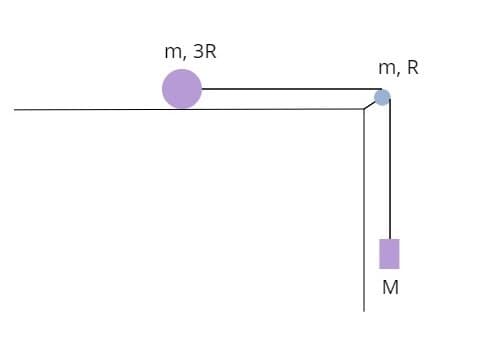A cylinder of mass m and radius 3R is attached to a block of mass M via a massless string that passes over a pulley of mass m and radius R (see figure 6). Initially, the block is kept in place and not allowed to move (you support it with your hand, for example), and then the block is let go. The pulley and the cylinder are not hollow. a) If the friction between the cylinder and the horizontal surface is zero, find the acceleration of the cylinder. Explain any assumptions you make. b) Suppose now that friction is present. What is the minimum value of the mass of the block M such that the cylinder slips on the horizontal surface? Does such a value even exist?
A cylinder of mass m and radius 3R is attached to a block of mass M via a massless string that passes over a pulley of mass m and radius R (see figure 6). Initially, the block is kept in place and not allowed to move (you support it with your hand, for example), and then the block is let go. The pulley and the cylinder are not hollow. a) If the friction between the cylinder and the horizontal surface is zero, find the acceleration of the cylinder. Explain any assumptions you make. b) Suppose now that friction is present. What is the minimum value of the mass of the block M such that the cylinder slips on the horizontal surface? Does such a value even exist?
Related questions
Question
A cylinder of mass m and radius 3R is attached to a block of mass M via a massless string that passes over a pulley of mass m and radius R (see figure 6). Initially, the block is kept in place and not allowed to move (you support it with your hand, for example), and then the block is let go. The pulley and the cylinder are not hollow.
a) If the friction between the cylinder and the horizontal surface is zero, find the acceleration of the cylinder. Explain any assumptions you make.
b) Suppose now that friction is present. What is the minimum value of the mass of the block M such that the cylinder slips on the horizontal surface? Does such a value even exist?

Transcribed Image Text:m, 3R
m, R
M
Expert Solution
This question has been solved!
Explore an expertly crafted, step-by-step solution for a thorough understanding of key concepts.
This is a popular solution!
Trending now
This is a popular solution!
Step by step
Solved in 4 steps with 1 images
